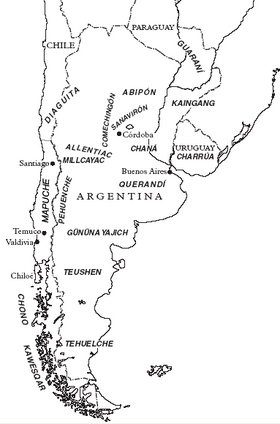Het peoples
Het is the term used by Thomas Falkner, an English Jesuit, at the end of the 18th century for various nomadic groups from the Argentine Pampas and Patagonia, including the so-called indigenous Pampas and northern Tehuelches, but excluding the Mapuche (speakers of Mapudungun).
Falkner subdivided the Het into the Chechehet, the Diuihet or Didiuhet, and the Taluhet. The easternmost Didiuhet, near modern Buenos Aires and influenced by the Guarani, were called the Querandí.[1] It is not clear if these peoples were related linguistically or only culturally.
The Het were neighbored on the north by the Chaná, on the northwest and west by the Mapuche, and on the south by the Puelche.
Peoples
The Het peoples are listed from north to south as follows.
- The Taluhet occupied the modern provinces of San Luis in the east, Córdoba, and Santa Fe in the west.
- The Diuihet (Divihet, Didiuhet, Diliuhet) inhabited the coastal region between the La Plata and Paraná rivers in Buenos Aires Province, southern Santa Fe, and inland through La Pampa and as far as Mendoza.
- The Chechehet lived as far south as the mouths of the Colorado and Río Negro rivers in southern Buenos Aires Province.
Language

For the linguist José Pedro Viegas-Barros, based on the work of Rodolfo Casamiquela, the Het languages are in fact "ghost languages" that never existed, the term arising from problems of interpretation.[2]
The supposed linguistic similarities between languages of different tribes, grouped by Falkner together as "Hets", are highly disputable.[citation needed] In particular, only two sentences and a few words recorded by French sailors around 1555 are known from the Querandí language. This evidence is too scarce to be able to conclusively identify a relationship, although on the basis of this little data, Viegas-Barros shows that the language of the Querandíes could have been related to the Gününa Küne.[2]
Vocabularies
Loukotka (1968) lists the following basic vocabulary items for Chechehet and Querandí;[3] Taluhet is unattested.
gloss Chechehet Querandí
(Didiuhet)two chivil moon zobá earth chu bow afia great hati
References
- ^ Th. Falkner: A description of Patagonia and the adjoining parts of South America, 1774
- ^ a b Viegas-Barros, José Pedro (1992). "La familia lingüística tehuelche" [The Tehuelche linguistic family]. Revista Patagónica (in Spanish) (54): 39–46.
- ^ Loukotka, Čestmír (1968). Classification of South American Indian languages. Los Angeles: UCLA Latin American Center.
